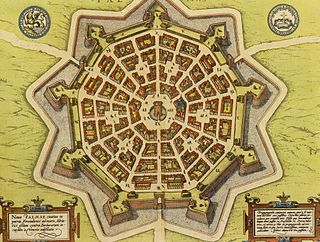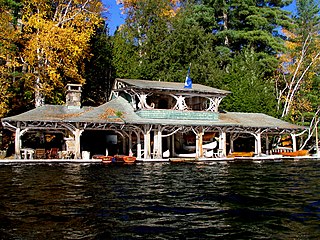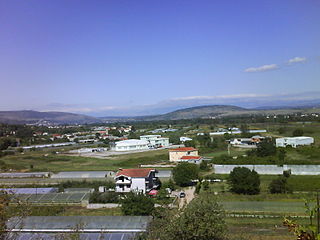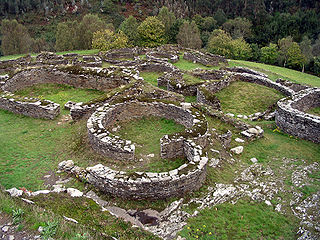This article needs additional citations for verification .(April 2022) |

A stockade is an enclosure of palisades and tall walls, made of logs placed side by side vertically, with the tops sharpened as a defensive wall. [1]
This article needs additional citations for verification .(April 2022) |

A stockade is an enclosure of palisades and tall walls, made of logs placed side by side vertically, with the tops sharpened as a defensive wall. [1]
Stockade is derived from the French word estocade. The French word was derived from the Spanish word estacada.
The troops or settlers would build a stockade by clearing a space of woodland and using the trees whole or chopped in half, with one end sharpened on each. They would dig a narrow trench around the area, and stand the sharpened logs side-by-side inside it, encircling the perimeter. Sometimes they would add additional defence by placing sharpened sticks in a shallow secondary trench outside the stockade. In colder climates sometimes the stockade received a coating of clay or mud that would make the crude wall wind-proof.[ citation needed ]
Builders could also place stones or thick mud layers at the foot of the stockade, improving the resistance of the wall. From that the defenders could, if they had the materials, raise a stone or brick wall inside the stockade, creating a more permanent defence while working protected.[ citation needed ]

The word stockade also refers to a military prison in an army camp. In some cases, the term was applied to a crude prison camp or a slave camp. In these cases, the stockade keeps people inside, rather than out.
Nowadays, stockade walls are often used as garden fencing, made of finished planks more useful for privacy fencing and more decoration than security.

A siege is a military blockade of a city, or fortress, with the intent of conquering by attrition, or by well-prepared assault. This derives from Latin: sedere, lit. 'to sit'. Siege warfare is a form of constant, low-intensity conflict characterized by one party holding a strong, static, defensive position. Consequently, an opportunity for negotiation between combatants is common, as proximity and fluctuating advantage can encourage diplomacy.

A fence is a structure that encloses an area, typically outdoors, and is usually constructed from posts that are connected by boards, wire, rails or netting. A fence differs from a wall in not having a solid foundation along its whole length.

A castle is a type of fortified structure built during the Middle Ages predominantly by the nobility or royalty and by military orders. Scholars usually consider a castle to be the private fortified residence of a lord or noble. This is distinct from a mansion, palace and villa, whose main purpose was exclusively for pleasance and are not primarily fortresses but may be fortified. Use of the term has varied over time and, sometimes, has also been applied to structures such as hill forts and 19th- and 20th-century homes built to resemble castles. Over the Middle Ages, when genuine castles were built, they took on a great many forms with many different features, although some, such as curtain walls, arrowslits, and portcullises, were commonplace.

A palisade, sometimes called a stakewall or a paling, is typically a row of closely placed, high vertical standing tree trunks or wooden or iron stakes used as a fence for enclosure or as a defensive wall. Palisades can form a stockade.

Trench warfare is a type of land warfare using occupied lines largely comprising military trenches, in which combatants are well-protected from the enemy's small arms fire and are substantially sheltered from artillery. It became archetypically associated with World War I (1914–1918), when the Race to the Sea rapidly expanded trench use on the Western Front starting in September 1914.

A fortification is a military construction designed for the defense of territories in warfare, and is used to establish rule in a region during peacetime. The term is derived from Latin fortis ("strong") and facere.

A gallows is a frame or elevated beam, typically wooden, from which objects can be suspended or "weighed". Gallows were thus widely used to suspend public weighing scales for large and heavy objects such as sacks of grain or minerals, usually positioned in markets or toll gates. The term was also used for a projecting framework from which a ship's anchor might be raised so it is no longer sitting on the seabed, riverbed or dock; "weighing [the] anchor" meant raising it using this apparatus while avoiding striking the ship's hull.

In the Roman Republic and the Roman Empire, the Latin word castrum was a military-related term.

A dugout or dug-out, also known as a pit-house or earth lodge, is a shelter for humans or domesticated animals and livestock based on a hole or depression dug into the ground. Dugouts can be fully recessed into the earth, with a flat roof covered by ground, or dug into a hillside. They can also be semi-recessed, with a constructed wood or sod roof standing out. These structures are one of the most ancient types of human housing known to archaeologists, and the same methods have evolved into modern "earth shelter" technology.

The Andersonville National Historic Site, located near Andersonville, Georgia, preserves the former Andersonville Prison, a Confederate prisoner-of-war camp during the final fourteen months of the American Civil War. Most of the site lies in southwestern Macon County, adjacent to the east side of the town of Andersonville. The site also contains the Andersonville National Cemetery and the National Prisoner of War Museum. The prison was created in February 1864 and served until April 1865.

Yatala Labour Prison is a high-security men's prison located in the north-eastern part of the northern Adelaide suburb Northfield, South Australia. It was built in 1854 to enable prisoners to work at Dry Creek, quarrying rock for roads and construction. Originally known as The Stockade of Dry Creek or just The Stockade, it acquired its current name from a local Kaurna word relating to inundation by water, which was used for the Hundred of Yatala.
The architecture of the California missions was influenced by several factors, those being the limitations in the construction materials that were on hand, an overall lack of skilled labor, and a desire on the part of the founding priests to emulate notable structures in their Spanish homeland. While no two mission complexes are identical, they all employed the same basic building style.

An electric fence is a barrier that uses electric shocks to deter people and/or other animals from crossing a boundary. The voltage of the shock may have effects ranging from discomfort to death. Most electric fences are used for agricultural fencing and other forms of non-human animal control, although they are also used to protect high-security areas such as military installations or prisons, where potentially-lethal voltages may be used. Virtual electric fences for livestock using GPS technology have also been developed.

A bastion fort or trace italienne is a fortification in a style that evolved during the early modern period of gunpowder when the cannon came to dominate the battlefield. It was first seen in the mid-fifteenth century in Italy. Some types, especially when combined with ravelins and other outworks, resembled the related star fort of the same era.

Tower and Stockade was a settlement method used by Zionist settlers in Mandatory Palestine during the 1936–39 Arab Revolt. The establishment of new Jewish settlements was legally restricted by the Mandatory authorities, but the British generally gave their tacit accord to the Tower and Stockade actions as a means of countering the Arab revolt. During the course of the Tower and Stockade campaign, some 57 Jewish settlements including 52 kibbutzim and several moshavim were established throughout the country. The legal base was a Turkish Ottoman law that was still in effect during the Mandate period, which stated that no illegal building may be demolished if the roof has been completed.
Vallum is either the whole or a portion of the fortifications of a Roman camp. The vallum usually comprised an earthen or turf rampart (Agger) with a wooden palisade on top, with a deep outer ditch (fossa). The name is derived from vallus, and properly means the palisade which ran along the outer edge of the top of the agger, but is usually used to refer to the whole fortification.

A boathouse is a building especially designed for the storage of boats, normally smaller craft for sports or leisure use. These are typically located on open water, such as on a river. Often the boats stored are rowing boats. Other boats such as punts or small motor boats may also be stored.

Gabela is a village in southern Bosnia and Herzegovina, 5 kilometres south of Čapljina and 4 kilometers from Metković, in Croatia. It is situated in the navigable lower course of the Neretva, off the major road linking the coast with the mountainous hinterland.

A castro is a fortified settlement, usually pre-Roman, some from late Bronze Age and Iron Age, associated with Celtic culture. These are frequently found in Northern Spain, particularly in Asturias, Galicia, Cantabria, Basque Country and the province of Ávila, with the Castro culture and on the plateau with Las Cogotas culture.

A palanka, also known as parkan in Southern Hungary and palanga, was a wooden fortification used by the Ottoman Empire extensively in certain regions of Southeast Europe, including Hungary, the Balkans and the Black Sea coast against rival states, especially the Archduchy of Austria and the Kingdom of Hungary. Such wooden forts could be built and expanded quickly, and usually contained a small garrison. These fortifications varied in size and shape but were primarily constructed of palisades. Palankas could be adjacent to a town and later they could be replaced by a more formidable stone fortress as in the case of Uyvar. Palankas could also be built as an extension of the main fortress. Many Ottoman forts were a mixture of palanka type fortifications and stonework. Evliya Çelebi describes the word palanka also as a technique of timber masonry.